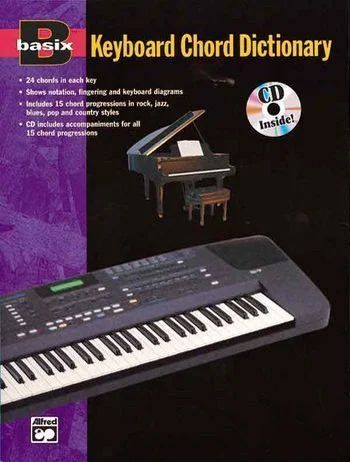

So where to from here? Here’s a quick (and certainly not comprehensive) wishlist, some things I think students need to learn in order to be genuinely fluent at reading ‘chart’, and in no particular order:ġ. Students need to learn to think around the geometry of every chord. And when we do teach our students anything about chord symbols it’s not really part of a coherent teaching plan beyond covering the basic major and minor chords.

#Jazz keyboard chord dictionary how to
Even if the teacher does not feel quite up to the task, the message is being heard that this notation is an integral part of pianistic literacy.Īnd I think that’s about where we as a profession are up to: we’re convinced it’s important, and we’ve been developing our own skills and knowledge, but on the whole we’re not quite sure how to systematically go about teaching our students anything much beyond how to figure out which notes are indicated by a chord symbol. Students will also bring to their lessons music they’ve been asked to play at school with the school band or accompanying a singer, music that is primarily notated by way of chord symbols. Whereas once upon a time teachers would be universally disdainful of the idea of teaching their piano students how to play popular music these days piano teachers conscientiously trawl through all kinds of music looking for material that will connect with their students’ interests and will inspire students to practice harder (or at all) and to maintain interest in piano lessons during those inevitable rocky months (or years) in early adolescence. This grass-roots change regarding chord charts also reflects a different approach to teaching, both from teachers and from students. A significant number of serious, high-end composers have been working with post-major/minor tonal language for some decades, and it is within tonality that some of the most interesting recent compositional trends have emerged. So here we are in 2011, and it turns out that the common practice major-minor tonality has truly been and gone, but tonality in a variety of other permutations rages on. For a while there in the second half of the twentieth century we were (albeit reluctantly) buying into the notion that music had moved ‘beyond’ tonality. It’s also about the state of play of musical style and music history. And of course we think it’s important – it’s how so much music we’ve spent our time playing is notated. My generation is now just getting into its 40s, and most of us have grown up fluent with this notation. For other teachers, however, playing from a chord chart has always been a part of their pianistic experience, albeit outside their official piano lessons. For some teachers that might mean that since 2000 they have put in the effort to learn how to play chord symbols and how to interpret the nuances of the different chord indications. I think piano teachers know how to do this because piano teachers think it’s important.
#Jazz keyboard chord dictionary professional
So piano teachers don’t need to know this in order to prepare students for exams.Īnd neither do piano teachers need to demonstrate a capacity to read a chord chart in the process of gaining a teaching diploma, membership of a teaching association or certification from a professional body. Piano exams still have no compulsory chord chart reading component (beyond maybe a perfect cadence in a sight reading exercise) apart from the niche ABRSM Jazz Piano exams, and while theory exams now allow chord symbols as answers a knowledge of chord symbols is not compulsory. No one is telling piano teachers they should acquire this skill, at least no one in a professional sense. Eleven years on and that percentage has almost flipped: I estimate at least 75% of piano teachers these days tell me they are perfectly comfortable reading a chord chart, and up to 99% say they understand what the chord symbols mean (even if they wouldn’t be comfortable performing from a chart). In 2000 I started presenting professional development seminars for piano teachers and when I would ask “who can read a chord chart?” maybe 10% of the teachers at the seminar might put up their hands.

Needless to say I found the fuss rather ridiculous and just wanted to get on with making music. To be fluent reading a ‘chart’ while also being able to play the Pathetique seemed to be about as musically transgressive as it was possible to be. degree and I could still read a chord chart. It shook the foundations of many a musician’s world that I had a B.Mus. A cliché I used to find myself confronting as a young musician in the mid-late 80s and the 90s was the idea that the world of pianists divides into the classically trained and those who can read chord charts.


 0 kommentar(er)
0 kommentar(er)
